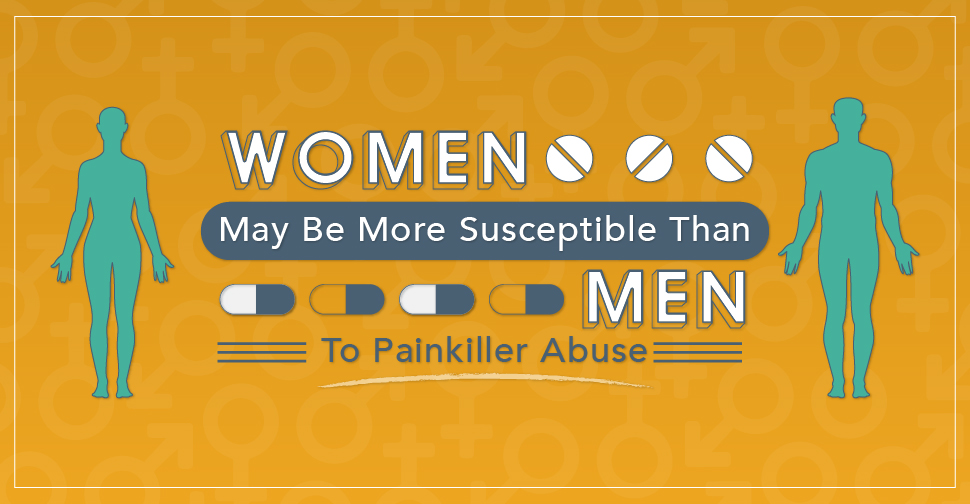
Painkillers are a vitally important tool for helping people recover from serious injuries. Unfortunately, they can be highly addictive if utilized improperly. And this problem seems to strike more women than men. Understanding why painkiller addiction is so common in women can help you find a solution that works for your or anyone you love that is suffering from this poorly understood problem.
Studies Confirm The Problem
Multiple studies seem to confirm that women are more susceptible to painkiller addiction than men. For example, a study in the Biology Of Sex Differences found that found that 52 percent of women addicted to opioids were introduced to their addiction through painkillers. This painkiller use led to a much higher rate of heroin use in women.
Another study, published by The Centers for Disease Control and Prevention, stated that nearly 18 women die from painkiller overdose every day. This surprised many addiction experts, because men have been shown to suffer more overdose deaths than women.
These two studies confirm that painkiller addiction strikes women at a higher rate than men. Unfortunately, they also confirm that it can also lead to more serious addictions and problematic usage later in life, usage that can lead to death. Understanding what causes this predilection towards painkiller addiction is crucial to understanding how to treat it.
What Causes It?
There are multiple theories on why women seem to be more vulnerable to painkiller addiction. One study, titled Females are More Vulnerable To Drug Abuse Than Males, found that women were prone to suffer more heavily during the key transition phases of drug addiction – initiation, binging, and relapse. Breaking down these sections and addressing how they affect women is illuminating:
- Initiation – this is the phase when a person is introduced to a drug. For women who are addicted to painkillers, initiation is often a result of suffering from an injury that requires a prescribed painkiller. And since studies have shown that women have a lower threshold of pain than men, initiation is more likely.
- Binging – this is the phase when a person begins taking their drug at a higher rate. The excessive amount of drugs in their system triggers a physical and mental addiction. And since women suffer from pain more acutely than men, they are more likely to use too much medicine to treat it.
- Relapse – this is the phase when a person starts using again after quitting. Women often relapse into painkiller addiction because their pain has not subsided. However, the same study previously mentioned also found that estrogen increases a woman’s pleasure and pain sensations, which makes relapse more likely.
The “passive” role men press on women often makes addiction more likely. This role makes it harder for women to say no, such as if their doctor prescribes them a pain medication or if a friend or family member gives them medicine to use without it being their own prescription.
Gender Roles Can Also Play A Part
When addressing painkiller addiction, few people take the time to consider the influence that gender roles play. Women, especially mothers, are often the most caring and nurturing members of the family. Unfortunately, this means they are more likely to ignore their painkiller addiction in order to “hold the family together.”
In fact, housemothers may feel they can’t attend rehab because they need to stay close to their children. This is especially true in families that may not be able to afford hiring a sitter or nanny if she were to go attend a rehab center.
What Can Be Done To Stop This Problem?
First of all, any woman with an addiction to painkillers needs to honestly assess the situation and understand that she has a problem. Any addiction is problematic, even if it is to a medicine that has been prescribed by a doctor. That understanding helps open the door to full recovery.
Next, the necessity of her painkiller needs to be medically assessed. Often, people who are addicted to painkillers continue using them long after the pain has disappeared. However, if there is still pain to be treated, doctors need to find an alternative treatment option. Physical therapy and holistic treatment options (such as massage therapy) are often useful in these situations.
Finally, a treatment option needs to be chosen. Treatment requires several steps – detoxification, rehabilitation, and aftercare. Detoxification helps safely eliminate all traces of the addictive painkiller from the body. Rehabilitation utilizes various treatments to improve their physical and mental health. And aftercare helps a person maintain sobriety after rehabilitation is finished.
Choosing between an inpatient and outpatient rehab requires addressing her specific needs. For example, a housemother may do well with outpatient care, because it lets her come home at night to spend time with her spouse and children. However, inpatient rehab may be necessary for anyone who suffers from a severe and debilitating addiction that requires constant care over a longer period of time.
 Interested In Learning More?
Interested In Learning More?
If you or someone you love is suffering from painkiller addiction, you need to reach out for help. Contact us at DrugRehab.org to speak to one of our helpful counselors. They will assess your problem, help you find a solution, and guide you through the process of implementation.
